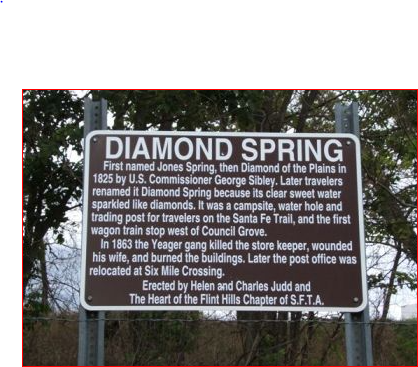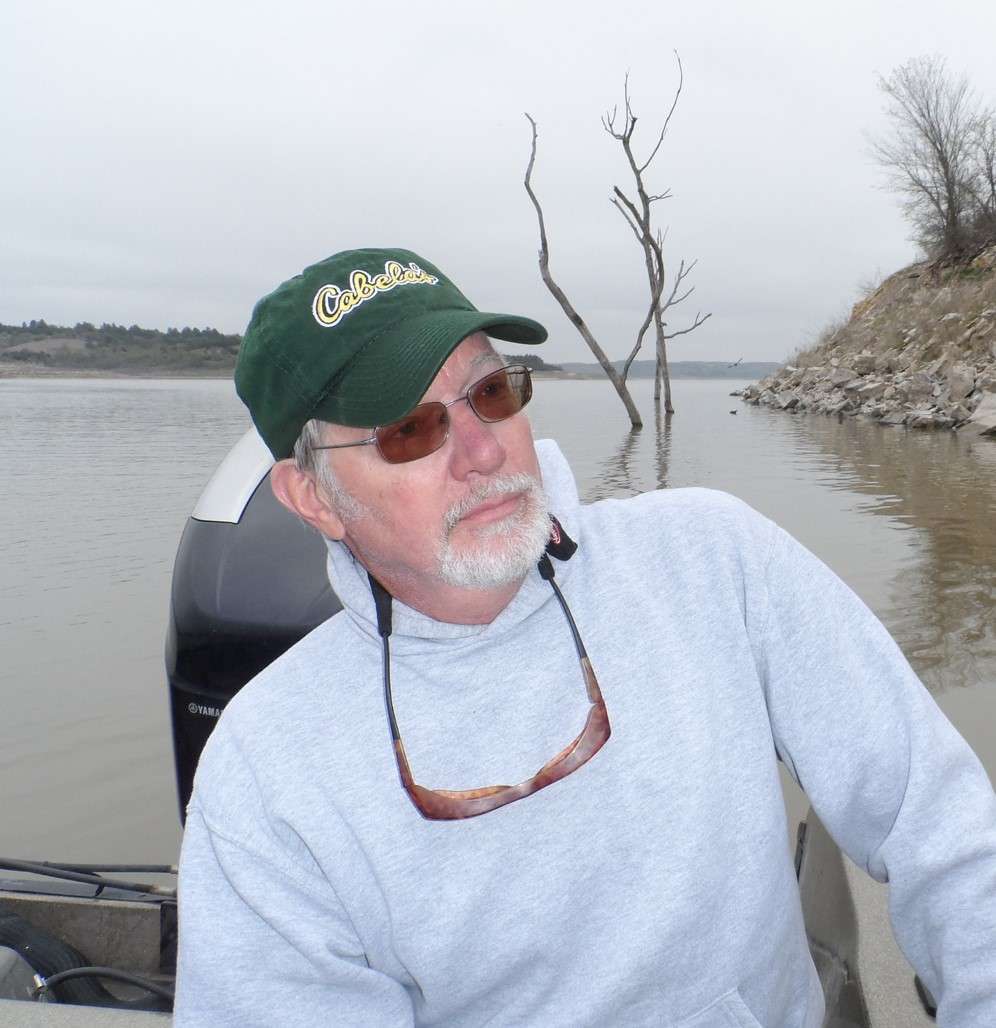Frequently if not nearly always, Diamond Spring and Diamond Springs are synonymous in lay conversation.
That’s inaccurate, but both are important to the history of Morris County.
Likewise both Diamond Spring and Diamond Springs had important roles for early travelers and settlers. Particularly that was true for those following the Santa Fe Trail during years of existence.
Okay, for quick reading scanners, clarification is necessary. Diamond Spring is a “natural spring of water” providing the most essential nutrient then and now: water. Early day prose and writings, describe Diamond Spring as having “clean sweet water sparkling like diamonds.”
Diamond Springs, that’s “Springs plural,” with an “s” at the end, was a community developed to serve railroad transportation. It is a “ghost town” today with only few reminders of what once was.
If this sounds complicated, it certainly can be for interested historians looking back nearly two centuries; that’s 200 years.
Timeframe perspective, Diamond Springs Post Office closed in 1930. Yet, the southwest Morris County community remains served by United School District 417.
According to Kenneth W. McClintock, likely Morris County’s most deliberately thoroughly accurate historian; Diamond Spring is located on private property.
The “spring” is west of 2200 Road, about 2.5 miles south of the intersection of U.S. 56 and K-177 highways. It is not visible from the county road.
Town site of Diamond Springs, with an “s,” is about 6.5 miles south of the intersection of U.S. 56 and K-177. Ranchers in the area today often readily acclaim their ranches as being in the Diamond Springs community.
In the 1825 survey of the Santa Fe Trail, the spring was named Jones Spring by U.S. Commissioner George Sibley, McClintock informed. That was in acknowledgement of Ben Jones, a hunter with the survey party, who discovered it on August 11, 1825.
It was not until Sibley re-surveyed part of the route in 1827 that he renamed the spring “The Diamond of the Plain.” A guide “Big John” Walker carved that name on an elm tree which overhung the spring.
“For trivia,” McClintock said, “he was the same ‘Big John’ Walker who, also in 1827, discovered the Big John Spring.” East of Council Grove, Big John Spring, from which Big John Creek was named, is also known as Fremont Spring.
The Civilian Conservation Corps (CCC) was Camp Fremont, now home of the Morris County Fairgrounds, with county highway department headquarters nearby. Established in 1933, CCC’s mission was to provide work and educational opportunities to the vast number of unemployed young men.
Sibley also named the creek into which Diamond Spring flows as “Otter Creek,” which has since been known as “Diamond Creek.”
In the Flint Hills’ bottomlands along Diamond Creek, ranchers produce feedstuffs for wintering livestock.
William Becknell is recognized as “Father of the Santa Fe Trail” thus being credited for its origin. Several Indian paths were combined creating a trail of commerce between the United States and Santa Fe, New Mexico. That city and province were then governed by Mexico.
“Diamond Spring campsite was considered a significant rendezvous point for westbound wagon trains,” according to historical writer Kathy Weiser-Alexander.
A mail station was established at Diamond Springs by Waldo, Hall & Company in 1849. David Waldo, Jacob Hall, and William McCoy were partners in the business.
“The impressive station complex was comprised of two large stone buildings,” Weiser-Alexander informed.
One served as a hotel, restaurant and saloon while the other was a warehouse and store. There was also a blacksmith shop and spacious livestock corrals
U.S. Dragoons, horse mounted infantry, were encamped close by in 1852 when Indians nearly destroyed their camp.
Sergeant Percival G. Lowe was a member of the unit. He recalled: “Returning from a trip to the forts along the border, we had seen little bands of Kaw Indians. They had no love for our troop even though we didn’t think they’d attack.
“We had finished supper when fire broke out around us roaring furiously flames from tall prairie grass leaping 20-feet high. Every man used a gunny sack or saddle blanket working with desperate energy. Success was ours, but the 15-minute battle with wildfire left exhaustion and scars on nearly all.”
Still, pioneers continued to come such the Diamond Springs Post Office opened in July 1859 with Postmaster George C. Newberry.
During the Civil War, on May 4, 1863, the Diamond Springs Stage Station was robbed and destroyed by Confederate bushwhackers. Their leader was Dick Yeager, who rode with William C. Quantrill, including the raid on Lawrence August 21, 1863.
Storekeeper Augustus Howell was killed and his wife severely wounded. Never rebuilt, the station was moved to Six Mile Creek, six miles from Diamond Springs.
Santa Fe Trail traffic through Diamond Springs stopped after the Union Pacific Railway, re-named the Kansas Pacific, reached Junction City in 1866.
The next year, Santa Fe freighters, bypassing Council Grove, offloaded at the Junction City railhead. They continued along the route west of where it intersected with the military road between Fort Riley and Fort Larned.
A railroad station at Diamond Springs was developed with arrival of the Atchison, Topeka and Santa Fe Railroad in 1887.
It became a shipping point for cattle coming from the Southwest to graze Flint Hills pastures. After summer weight gains on native Bluestem, the cattle were shipped for terminal slaughter such as in Kansas City.
“In 1910, Diamond Springs had 27 people, although population continued declining,” Weiser-Alexander said. “The old town site is now owned by an area rancher. It is marked only by signs, a couple homes, stone ruins, and the cemetery.”
The spring was capped many years ago, with two underground pipes discharging the output of water. One pipe goes to a large livestock water tank and the other empties into a stream flowing into Diamond Creek.
“There is definitely a difference between the singular Diamond Spring and today’s ghost town Diamond Springs,” McClintock emphasized.
CUTLINES
Often referred to as Diamond Springs the historic watering place on the Santa Fe Trail here is designated singular: “Diamond Spring.” The sign was erected by the late Helen and Charles Judd and the Heart of the Flint Hills Chapter of the Santa Fe Trail Association.
This gravel road sign marks location of Diamond Springs in western Morris County.
The Diamond Springs Store operated in the small rural western Morris County community Diamond Springs more than a century ago. (Kathy Weiser-Alexander photo)
So many stories of Diamond Spring, the Santa Fe Trail, and the Diamond Springs community are buried in the Diamond Springs Cemetery. (Kathy Weiser-Alexander photo)
Ruins of a stone building from the mid-1800s remain in the ghost town Diamond Springs. (Kathy Weiser-Alexander photo)





